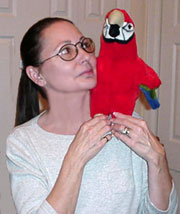![]() Avian CPR and Rescue Breathing
Avian CPR and Rescue Breathing
 Buddy, the CPR demonstration Macaw. |
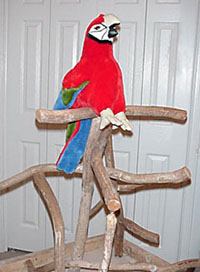 Buddy is feeling well. |
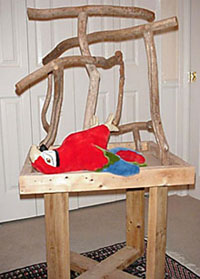 Buddy is not feeling well. |
Here's the scoop on bird CPR and Rescue breathing. It is very similar to techniques used on humans, but with a few important differences.
|
Remember to listen, look and feel for breathing, clear airway and heartbeat. Inspiration for this article came from Stevie Ray, a very tenacious little Ringneck Photographs by Jonathan Smith |
For those of you who have learned human CPR you may recall the three most important things to evaluate before initiating the technique. These three things are breathing, airway and pulse.
You put your head down to the person's mouth and nose to listen and feel for breath. You watch their chest for respiration movement. You open and check their mouth to see that it is clear, actually sweeping your finger around inside their mouth to insure there is nothing blocking the airway. You tilt their head back to keep the airway open. You feel for pulse and listen for a heartbeat.
You never do chest compressions on someone who's heart is beating. It could do harm.
If there no respiration, a clear airway and there is pulse/heartbeat you start Rescue Breathing. If there is no respiration, a clear airway and there is no pulse/heartbeat you start CPR.
You would evaluate your bird for the same things if you found it down and out. Look at the breast and abdomen to see if it is moving due to respiration. Open the beak and look into the mouth to see if there is a blockage. Clear it with your finger or a cotton swab if there is. Put your ear to their breast and listen for a heartbeat. If you have a stethoscope, even better.
If there is no respiration, a clear airway and there is a heartbeat then start Rescue Breathing.
Hold the bird in front of your face, tilted slightly away from you with one hand supporting its head and the other its body. Open the beak if necessary. Turn your head a quarter turn to the left or right and put your mouth over the bird's beak. Take a breath, seal your lips around the beak and nares for a small bird or only the beak and put your index finger over the nares for a larger bird. Blow five quick breaths into the birds beak. The strength of your breath should be governed by the size of the bird. For a little bird like a Budgie just little puffs will do. For a large bird like a Macaw you will have to breathe more air in to fill the lungs and air sacs.
Watch the breast to see if it rises with each breath you puff in. You can see it clearest just where the breast muscles meet the abdomen. If the breast is not rising then you are not getting air into the lungs and need to check again for blockage. If the bird's breast is rising with your puffs, then pause after five breaths and watch for a second to see if the bird has begun breathing on its own again. If breathing has not resumed, then puff two breaths and pause a second to check for breathing again. Continue this pattern until the bird has resumed breathing on it's own. Check periodically for heartbeat by putting your ear to the bird's breast and listening.
If there is no respiration, a clear airway and no heartbeat or if you lose heartbeat while doing Rescue Breathing then you have to go into CPR and add chest compressions.
Birds normally have a very rapid heartbeat so you will try and simulate that with gentle, rhythmic finger pressure on the sternal keel. For little birds like budgies I use one finger and for larger birds like macaws I use three fingers. The pressure will be lighter for a small bird, stronger for a large bird. Use enough pressure to depress the sternum down. You want to press quickly at a rate of about 40-60 compressions a minute, while giving two breaths to the bird about every ten compressions. Check every minute or so for heartbeat and respiration.
So the pattern for CPR is: Five quick breaths, ten compressions, check for heartbeat and respiration, two breaths, ten compressions, two breaths, ten compressions and so on for a full minute then check vitals again.
Repeat the sequence as needed. It helps to count out loud as you go. Once recovered, place the bird in a warm supportive environment and call your avian vet for further guidance.
If you have never taken a CPR class I urge you to do so. It will help you learn these skills and have the confidence to use them. You can practice avian CPR and Rescue Breathing on a stuffed toy bird just as we practice on the Anne doll in human training. Please do not practice this on your conscious, breathing birds. Besides being harmful for them you could get your tongue and lips bitten.
EVALUATING THE
BIRD
If there is no respiration,
but there is heartbeat start rescue breathing.
If there is no respiration and no heartbeat start CPR.
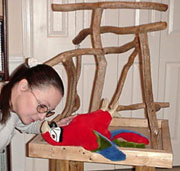 Listen.look and feel for respiration |
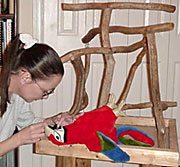 Check for clear airway |
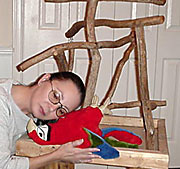 Listen and feel for heartbeat |
|
RESCUE
BREATHING |
||
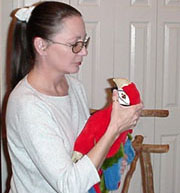 Position the bird |
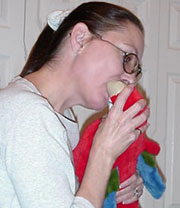 Tilt, seal lips over beak, forefinger over nares and puff breath |
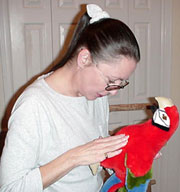 Check breathing and heartbeat |
|
CPR-CARDIOPULMONARY
RESUSCITATION |
||
 Breath five breaths into the bird |
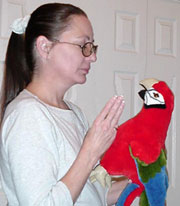 Three fingers on the bird's sternum |
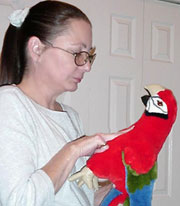 Compress the sternum down |
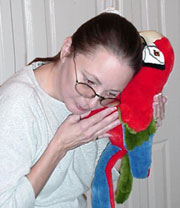 Check heartbeat and respiration |
 Continue breathing... |
 Continue compressions.. |
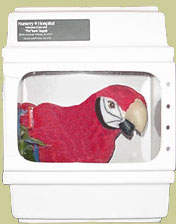
When breathing and heartbeat resume, place bird in a supportive environment and call your avian veterinarian. |
||
HEALTH |
BASIC CARE | ILLNESS AND INJURY
| SYSTEMS | FEATHER PROJECT | TAMBOPATA | VAL | LINKS
AVIAN VET | CHECK-UP | DROPPINGS | DIAGNOSTICS | EMERGENCIES | COMMON
INJURIES | CPR | WEST NILE VIRUS | IMMUNE | REPRODUCTION
DIET | ENVIRONMENT
© kgsmith 2011
No content may be used or reproduced without the author's written permission
DO NO HARM

